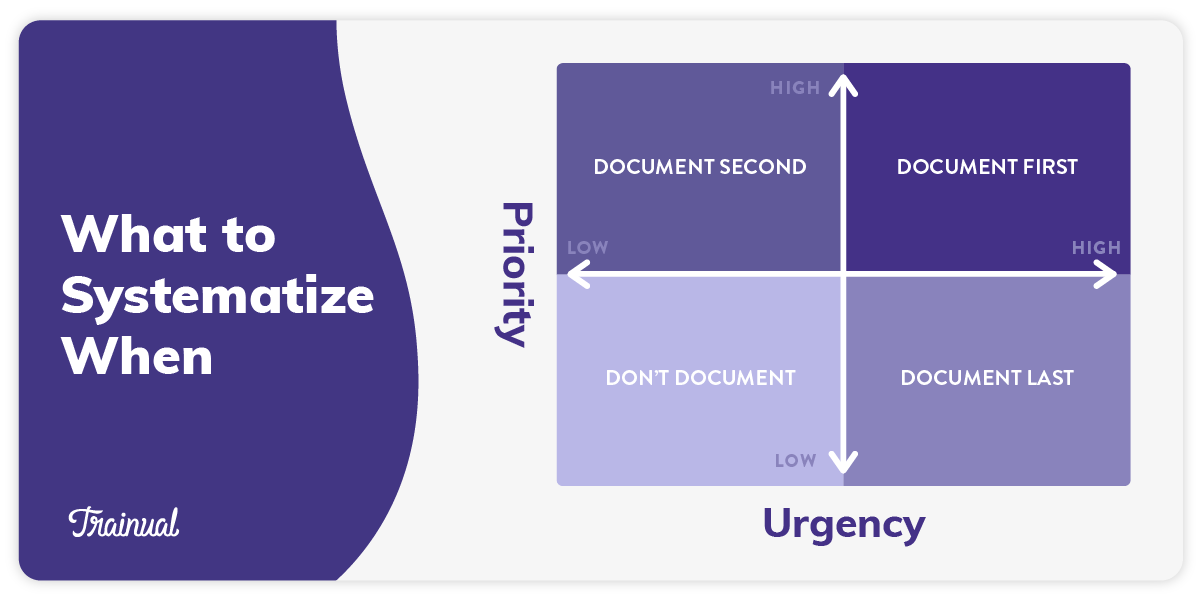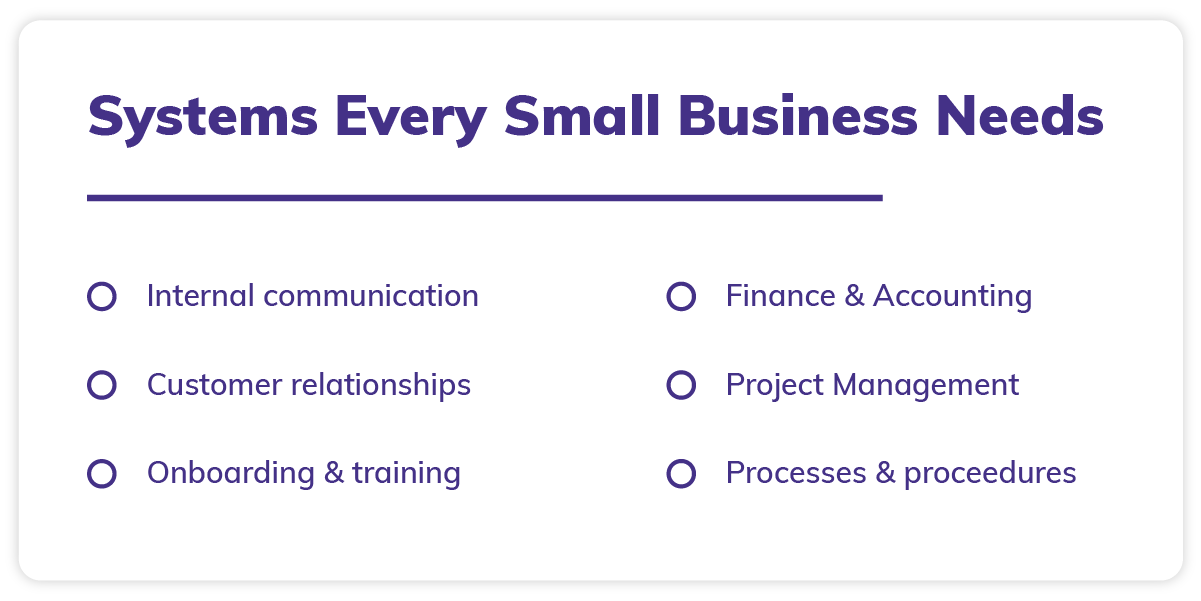
Articles
How To Systemize Your Small Business [in 5 Simple Steps]
December 16, 2020

When you first launch your business, it's all about figuring out how you do things and getting them done. But as your business matures, you settle into the way you do things. And you (most of the time) naturally systemize your business process.
That's because it's easier to run day-to-day — not to mention much more productive and cost-effective — when everyone knows the correct way of doing things. Meaning, you can step away from the ground level and focus on the bigger picture.
But while it’s great that systems might accidentally fall into place, that's not a scalable strategy. So, here's how you can intentionally systematize and systemize your business. Plus, what exactly you should systemize:
How to systemize your business
To systemize is to arrange something according to a method or specific steps so that people can interact with it in a more standardized manner.
<iframe width="840" height="472" src="https://www.youtube.com/embed/yTnWsGyN7oQ" title="What Does it Mean to Systematize Your Business?" frameborder="0" allow="accelerometer; autoplay; clipboard-write; encrypted-media; gyroscope; picture-in-picture; web-share" allowfullscreen></iframe>
While it’s not necessary to systemize everything, there’s no excuse not to systemize your business. When everyone has the same parameters to work within, they’re more productive and more confident at work.
Plus, how you do what you do becomes more manageable because everyone knows what they’re supposed to be doing. There is less room for guessing and error.
Here at Trainual, we like to think about business systemization like building a Lego toy with the instructions. Meaning, it’s super easy to do it right.
Imagine trying to build the same toy - never having done it before - by only looking at the picture on the box. Suddenly, the same task is a lot more complicated and going to waste a lot of time. Seriously, no one should have to go through that - especially not your employees.
Ironically enough, there’s no perfect system for systemizing your business. And a lot of the time, companies over-complicate how they go about it.
But we like to keep things as simple as possible here at Trainual. So, we’ve documented our proven 5-step process for systemizing your business that any small business (and we mean any small business) can put to use.
Here’s how to systemize your small business:
1. Make a game plan
Before you start building business systems, gather all the nuts and bolts that you think you’re going to need. This is one of those cases where it’s better to have too much than not enough. Otherwise, chances are good you’ll get halfway through building it and realize you’re missing a critical part.
To make sure I don’t miss anything, I always start with a list. Choose one area of your business that you think could run more efficiently or you want to scale. Then, jot down everything and anything that goes into it. Processes, policies, procedures, and best practices included.
For example, if you’re systematizing your email, write down the different kinds of emails you get. Such as updates from coworkers, partnership agreements from vendors, invoices, spam, and networking opportunities.
Then, mark if things are high priority or low priority (AKA do they take your business to the next level). Do the same for urgency (AKA does this task need to be repeated often). That way, you can see point-blank which parts actually are crucial to making the system work — and which can be ignored.

I’ve found that it’s easiest to visualize these items. So I’ll even put each item onto a quadrant with priority on one axis and urgency on another.
You’ll want to document items that are both high priority and high urgency first. And then anything that is either high priority or high urgency. But don’t bother focusing on the ones that are low priority and low urgency - most of the time, they're not worth the investment.
🔥 Tip: Document your systems as you create them so you can easily hand them off to your team and scale them. And use Trainual to assign out the content so you can see who knows what — and hold people accountable. Book a demo to try for free.
2. Document one part at a time
For me, this is your business equivalent to cleaning out a closet. First, you take out everything so you can see it - knowing it will initially make a bigger mess. Then, you put things away, one by one, like with like.
So, with whatever area you want to systematize first (the one listed out with priorities set), it's time to start putting things away. Or, in this case, documenting them.
Focusing on the highest priority and highest urgency part, start writing down exactly how you do it as an SOP. You'll want to answer the questions who, what, where, when, and how with as much nitty-gritty details as possible.
🔥 Tip: If you are struggling to explain how you do a specific step, show it instead! Using whatever camera you have on hand, take screenshots, pictures, or videos of it in action.
By the time you're done, you should be able to hand it off to anyone on your team. And that person should be able to use your documentation and get the desired results — without your help or further instructions. (If you're not sure that your SOP can do this, try actually handing it off to someone who's never done it before.)
Then, wash and repeat with the next highest priority and urgency item until you've documented every part of this system. (At least the ones that you're going to document.) Then, move onto the next one.
And don't worry about making sure how you do things now is the end-all best way. You can always revisit how you do things and change your systems down the line. (Just be sure to document the new, better way of doing things.)
🔥 Tip: Documenting your systems is a big lift. So rather than trying to do it all at once, break it into bite-sized portions. Block out 30 minutes a day on your calendar to document one process or procedure. This will keep it from being overwhelming (and help you stick to it)!
3. Get your team involved
I'll be real with you - documenting your business takes a lot of work upfront. But you don't have to do it all on your own. Like every other aspect of your business, systematizing and documenting is a team sport.
So if you want it done fast and done right, you'll need your top players off the bench. That way, you can tackle documenting your systems together - rather than putting it all on you!
Plus, then, what you document (AKA the knowledge your entire company will use moving forward) will be the culmination of all your top player's best moves. Not just your own. Because sometimes, the way you've always done things isn't the best, safest, or most efficient.
Here at Trainual, we have everyone document the part of the business they own. After all, who knows the processes better than the person who actually does them? (If more than one person owns that part, we’ll have our top player take the lead. AKA the person who is always finding an even better way to do things!)
So, for example, our social media person will document how we use Instagram. And if we find a better way to do it (we're always looking), it's up to them to update the documentation.
🔥 Tip: With Trainual's Subject Owner feature, you can assign content directly to your team members to build it out and keep up to date. Try for free.
4. Train your team on those systems
You've put in the work to systematize your business. Now, it's time to get your team on the same page. AKA aligned and accountable.
That way, there's no excuse for guesswork or inconsistencies. And tasks are always done the same way - no matter who does them.
And no surprise, but we love Trainual for this! (We're not biased, just the best according to G2.) Trusted by thousands of teams in 120+ countries, Trainual is the proven system for getting your team fully up to speed faster.
Just assign all the documentation on your company's systems directly to anyone who needs to know them. And Trainual will take care of the rest. You can even track who knows what and test for understanding - right from the tool. Plus, if someone on your team forgets how to do something, they can look it up in seconds using the Trainual mobile app.
👉 Make sure your team goes through the need-to-knows sooner rather than later using our Due Dates feature. (We suggest making it due within 7 days!) Try for free.
5. Delegate those systems
With your business systematized and your team trained, it's time to put your business systems development to work (literally). And finally, take yourself out of the day to day.
Circling back to that list you made earlier, delegate all the routine operations that don't need to be on your plate. But feel free to keep the big picture and strategic items on your to-do list.
I personally like to delegate the super high priority and urgency tasks (AKA the things my team can't afford to mess up) to my direct reports. That way, I can keep a constant pulse on how they're doing and if they're still working — without needing to do it myself.
Then, I delegate the rest of the delegating to the head of the closest department. Meaning, my Head of CX assigns out who owns each individual part of the customer relationship system.
That way, you can easily spot check how well every part is working. And if you're not getting the results you want, your team can quickly troubleshoot the disconnect.
Systemize vs. systematize: what’s the difference?
Systemize (in addition to being less of a mouthful) means to create a system from something. For example, gathering all of your customer data and using it to build a customer FAQs page is systemizing.
Whereas, to systematize means to make something that already exists into a fixed system. For example, turning a casual breakroom meeting into a formal meeting is systematizing.
But at the end of the day, they essentially mean the same thing and can be used interchangeably. If you’re asking if you should systemize or systematize your business - the answer is yes!
Either way, you’re building processes and procedures for your team to follow. And you're making repeatable systems that anyone on your team can step up and do. That way, what you do is done the same way again and again - even if you're not there. And it's easier to scale!
What are the benefits of business systemization?
For a growing business, systemizing your processes is crucial. It's how you can free yourself from doing all the grunt work and get more time for strategic work. Here are 3 more benefits of systemizing your small business:

1. Improved organization
We’ve all been there - searching for a how-to or need-to-know in Google Docs and trying to remember what it’s named or who owns it. It’s frustrating at best and complete chaos at worst.
But systematizing your business, well, gives you a working system. So you and your team never again have to frantically search for the right way of doing things.
For one, systematizing makes sure there's one standardized way that your business does things (AKA creates standard operating procedures). But it also makes sure those SOPs are always where you put them - and easy to find when you need them.
So you can say goodbye to some of the headaches that come with running your business. Because everyone does things the same way. And if they don't know how, they know exactly where to go to learn it - without wasting any time. Meaning, fewer mistakes and more gets done.
🔥 Tip: Trusted by thousands of growing small businesses in 120+ counties, Trainual is the #1 training tool that puts everything your team needs to know in one place. Book a demo.
2. More confident delegation of duties and tasks
Plainly put, you can't scale your business if you're stuck doing all the work yourself. But a lot of the time, business owners don't feel comfortable delegating it off to someone else, so that's what happens: they do as much as they possibly can on their own.
And while this might mean a little less worrying in the short term, it costs you big in the long run. That's because you're not spending what the work is actually worth. You're spending whatever your salary is - and putting more pressing priorities (ones that could make you more money) off in the process.
So by building concrete business systems, anybody can play any position - including yours (which is what you want). That doesn't mean that everyone needs to be trained on how to do your job. But that there should be training available for someone to step up when need be.
That way, you can delegate confidently — without worrying about it getting it done or doing it yourself. And even if the person doing it is brand new to the task, they know the system for looking up how exactly you want it done. So that's how they'll do it.
3. Opens up scope to scale the business
According to Scott Fritz, serial entrepreneur and author behind 40 Hour Work Year, a company's success and scalability hang on the founder getting out of the way. AKA systematizing your business.
That's because the less involved you are in the daily operations and decision-making processes, the more your team needs to rely on established systems. And in turn, the more productive and profitable your company will be.
For example, in 1913, Henry Ford installed the first moving assembly line in Ford Automotive's Highland Park plant. Each person along the line was given one job (such as putting in one piece of the motor), which they did exclusively and repeatedly throughout their entire shift. Someone else would take the next part.
With the innovation, a car that once took 12 hours to assemble now took an hour and a half. Henry was able to mass-produce his Model T, and Ford's profits skyrocketed. Simply because he systematized the way the car was built.
6 small business systems and processes

Not sure where to begin creating business systems? Here are 6 systems that every business (including yours) needs:
- Internal communication. Meetings, emails, Zoom calls, and in-person conversations included. This is how you discuss opportunities, make decisions, and recap successes.
- Customer relationships. AKA the most important aspects of your business. Basically, how do you turn customers into raving fans for your product or service?
- Onboarding & training. This is how you consistently make sure every new hire gets fully up to speed quickly - and stays that way.
- Project management. Your business is always going to have a lot going on. How do you manage all the smaller projects without having anything fall through the cracks?
- Finance & accounting. Basically, how you manage your company’s money - everything from cash flow to taxes to budgeting for departments.
- Processes & procedures. Meaning, your own version of the Ford assembly line. That way, efficiency is always high, and error is low.
Systemizing your business frees you to do more strategic work
Without an established way of doing things, you constantly have to hand-hold your staff. Sometimes you end up doing work that you should be confidently delegating. If you systemize, though, your business works like a well-oiled machine - even when you're not there. So you can confidently step back and focus on scaling your business!
👉 Systemize your business today with Trainual! Book a demo.
Similar Blog Posts











